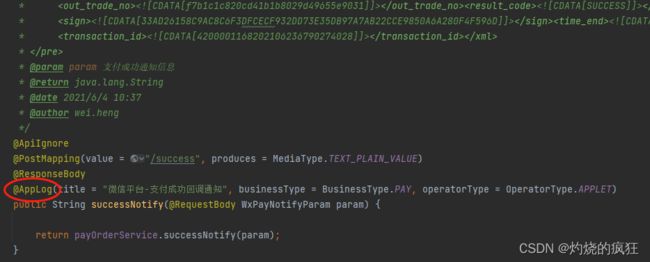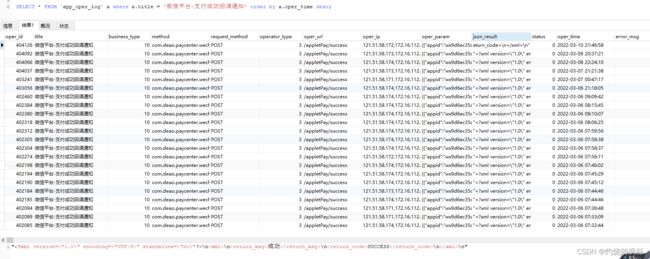自定义日志注解
前言
通过自定义注解,实现方法调用的日志记录 - 记录入参出参
这些代码以后项目中可能用得上,记录一下,免得再写一次
正文
AppLog
import com.applet.common.log.enums.BusinessType;
import com.applet.common.log.enums.OperatorType;
import java.lang.annotation.*;
/**
* 自定义移动端操作日志记录注解,对关键业务进行操作记录(不需要所有操作都记录)。比如购买课程、收藏课程等
* @date 2020/11/12 10:06
* @author wei.heng
*/
@Target({ ElementType.PARAMETER, ElementType.METHOD })
@Retention(RetentionPolicy.RUNTIME)
@Documented
public @interface AppLog
{
/**
* 模块
*/
String title() default "";
/**
* 功能
*/
BusinessType businessType() default BusinessType.OTHER;
/**
* 操作人类别
*/
OperatorType operatorType() default OperatorType.MANAGE;
/**
* 是否保存请求的参数
*/
boolean isSaveRequestData() default true;
}
AppLogAspect
import com.alibaba.fastjson.JSON;
import com.applet.common.core.constant.CacheConstants;
import com.applet.common.core.utils.ServletUtils;
import com.applet.common.core.utils.StringUtils;
import com.applet.common.core.utils.ip.IpUtils;
import com.applet.common.log.annotation.AppLog;
import com.applet.common.log.enums.BusinessStatus;
import com.applet.common.log.service.AsyncAppLogService;
import com.applet.system.api.appdomain.AppOperLog;
import lombok.extern.log4j.Log4j2;
import org.aspectj.lang.JoinPoint;
import org.aspectj.lang.Signature;
import org.aspectj.lang.annotation.AfterReturning;
import org.aspectj.lang.annotation.AfterThrowing;
import org.aspectj.lang.annotation.Aspect;
import org.aspectj.lang.annotation.Pointcut;
import org.aspectj.lang.reflect.MethodSignature;
import org.springframework.beans.factory.annotation.Autowired;
import org.springframework.core.annotation.Order;
import org.springframework.http.HttpMethod;
import org.springframework.stereotype.Component;
import org.springframework.web.multipart.MultipartFile;
import javax.servlet.http.HttpServletRequest;
import javax.servlet.http.HttpServletResponse;
import java.lang.reflect.Method;
/**
* 移动端日志记录处理
* @date 2020/11/16 16:39
* @author wei.heng
*/
@Order(20)
@Aspect
@Log4j2
@Component
public class AppLogAspect {
private final int MAX_LOG_LENGTH = 2000;
@Autowired
private AsyncAppLogService asyncAppLogService;
// 配置织入点
@Pointcut("@annotation(com.applet.common.log.annotation.AppLog)")
public void logPointCut()
{
}
/**
* 处理完请求后执行
*
* @param joinPoint 切点
*/
@AfterReturning(pointcut = "logPointCut()", returning = "jsonResult")
public void doAfterReturning(JoinPoint joinPoint, Object jsonResult)
{
handleLog(joinPoint, null, jsonResult);
}
/**
* 拦截异常操作
*
* @param joinPoint 切点
* @param e 异常
*/
@AfterThrowing(value = "logPointCut()", throwing = "e")
public void doAfterThrowing(JoinPoint joinPoint, Exception e)
{
handleLog(joinPoint, e, null);
}
protected void handleLog(final JoinPoint joinPoint, final Exception e, Object jsonResult)
{
try
{
// 获得注解
AppLog controllerLog = getAnnotationLog(joinPoint);
if (controllerLog == null)
{
return;
}
// *========数据库日志=========*//
AppOperLog operLog = new AppOperLog();
operLog.setStatus(BusinessStatus.SUCCESS.ordinal());
// 请求的地址
String ip = IpUtils.getIpAddr(ServletUtils.getRequest());
operLog.setOperIp(ip);
// 返回参数
String jsonResultStr = JSON.toJSONString(jsonResult);
operLog.setJsonResult(StringUtils.substring(jsonResultStr, 0, MAX_LOG_LENGTH));
operLog.setOperUrl(ServletUtils.getRequest().getRequestURI());
HttpServletRequest request = ServletUtils.getRequest();
String username = request.getHeader(CacheConstants.DETAILS_USERNAME);
if (StringUtils.isNotBlank(username))
{
operLog.setOperName(username);
}
if (e != null)
{
operLog.setStatus(BusinessStatus.FAIL.ordinal());
operLog.setErrorMsg(StringUtils.substring(e.getMessage(), 0, MAX_LOG_LENGTH));
}
// 设置方法名称
String className = joinPoint.getTarget().getClass().getName();
String methodName = joinPoint.getSignature().getName();
operLog.setMethod(className + "." + methodName + "()");
// 设置请求方式
operLog.setRequestMethod(ServletUtils.getRequest().getMethod());
// 处理设置注解上的参数
getControllerMethodDescription(joinPoint, controllerLog, operLog);
// 方法入参
operLog.setOperParam(JSON.toJSONString(joinPoint.getArgs()));
// 保存数据库
asyncAppLogService.saveAppLog(operLog);
}
catch (Exception exp)
{
// 记录本地异常日志
log.error("==前置通知异常==");
log.error("异常信息:{}", exp.getMessage());
exp.printStackTrace();
}
}
/**
* 获取注解中对方法的描述信息 用于Controller层注解
*
* @param log 日志
* @param operLog 操作日志
* @throws Exception
*/
public void getControllerMethodDescription(JoinPoint joinPoint, AppLog log, AppOperLog operLog) throws Exception
{
// 设置action动作
operLog.setBusinessType(log.businessType().ordinal());
// 设置标题
operLog.setTitle(log.title());
// 设置操作人类别
operLog.setOperatorType(log.operatorType().ordinal());
// 是否需要保存request,参数和值
if (log.isSaveRequestData())
{
// 获取参数的信息,传入到数据库中。
setRequestValue(joinPoint, operLog);
}
}
/**
* 获取请求的参数,放到log中
*
* @param operLog 操作日志
* @throws Exception 异常
*/
private void setRequestValue(JoinPoint joinPoint, AppOperLog operLog) throws Exception
{
String requestMethod = operLog.getRequestMethod();
if (HttpMethod.PUT.name().equals(requestMethod) || HttpMethod.POST.name().equals(requestMethod))
{
String params = argsArrayToString(joinPoint.getArgs());
operLog.setOperParam(StringUtils.substring(params, 0, MAX_LOG_LENGTH));
}
}
/**
* 是否存在注解,如果存在就获取
*/
private AppLog getAnnotationLog(JoinPoint joinPoint) throws Exception
{
Signature signature = joinPoint.getSignature();
MethodSignature methodSignature = (MethodSignature) signature;
Method method = methodSignature.getMethod();
if (method != null)
{
return method.getAnnotation(AppLog.class);
}
return null;
}
/**
* 参数拼装
*/
private String argsArrayToString(Object[] paramsArray)
{
String params = "";
if (paramsArray != null && paramsArray.length > 0)
{
for (int i = 0; i < paramsArray.length; i++)
{
if (!isFilterObject(paramsArray[i]))
{
try
{
Object jsonObj = JSON.toJSON(paramsArray[i]);
params += jsonObj.toString() + " ";
}
catch (Exception e)
{
}
}
}
}
return params.trim();
}
/**
* 判断是否需要过滤的对象。
*
* @param o 对象信息。
* @return 如果是需要过滤的对象,则返回true;否则返回false。
*/
public boolean isFilterObject(final Object o)
{
return o instanceof MultipartFile || o instanceof HttpServletRequest || o instanceof HttpServletResponse;
}
}
AsyncAppLogService
再看时,觉得这里的 @Async 其实可以改成自定义线程池
若用默认线程池的话,可以改成自定义参数配置,这里当时没做相关操作
import com.applet.system.api.RemoteAppLogService;
import com.applet.system.api.appdomain.AppOperLog;
import org.springframework.beans.factory.annotation.Autowired;
import org.springframework.scheduling.annotation.Async;
import org.springframework.stereotype.Service;
/**
* 异步调用日志服务
* @date 2020/11/12 10:21
* @author wei.heng
*/
@Service
public class AsyncAppLogService
{
@Autowired
private RemoteAppLogService remoteAppLogService;
/**
* 保存系统日志记录
*/
@Async
public void saveAppLog(AppOperLog appOperLog)
{
remoteAppLogService.add(appOperLog);
}
}

